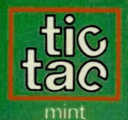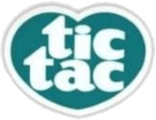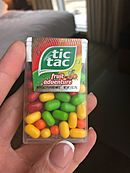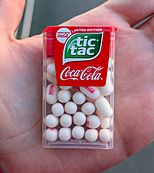Tic Tac facts for kids
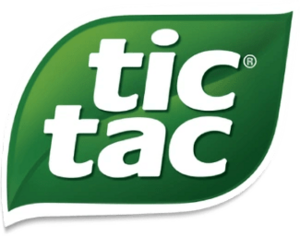 |
|
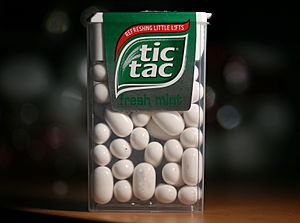 |
|
| Type | Breath mints |
|---|---|
| Owner | Ferrero |
| Country | Italy |
| Introduced | 1969 |
| Markets | Worldwide |
Tic Tac is a famous brand of small, hard mints. They are made by the Italian company Ferrero, which also makes Nutella and Kinder Surprise. First sold in 1969, Tic Tacs are now enjoyed in more than 100 countries.
Tic Tacs come in clear plastic boxes with a special flip-top lid. This lid is attached with a living hinge, which is a thin piece of plastic that can bend many times without breaking. When the brand first started, the mints were colored to match their flavor. Now, in many places, the boxes are colored instead, and the mints inside are white.
One of the things Tic Tacs are known for is being low in calories. Most flavors have only about 1.9 calories in each tiny mint.
Contents
The Story of Tic Tac
The company Ferrero first created these mints in 1969. They were originally called "Refreshing Mints." A year later, in 1970, the name was changed to Tic Tac. This new name came from the "tic" and "tac" sound the box makes when you open and close it.
A World of Flavors
The first flavors were original mint and orange. Over the years, many more have been added, including:
- Aniseed (licorice flavor)
- Cinnamon
- Spearmint
- Sour Apple
- Cherry
- Passionfruit (2007)
- Pomegranate (2010)
- Mango
- Popcorn (2014)
Some flavors were only available for a short time. The grape flavor was stopped in 1976 because of concerns about the red food coloring used to make it.
Special Editions and Slogans
Tic Tac often releases special packs for holidays like Christmas, Easter, and Valentine's Day. They also create limited-edition flavors to promote movies and TV shows. For the 2015 movie Minions, there was a banana and mandarin flavor. There have also been special flavors for The Simpsons, Coca-Cola, and Sprite.
Since 1980, the slogan for Tic Tac in the United States has been "The 1½ Calorie Breath Mint." In other countries like the United Kingdom and Australia, the slogan is "Two hours of Tic Tac freshness in less than two calories."
In 2008, a new type called Tic Tac Chill was introduced. These mints are a little bigger than regular Tic Tacs and are sugar-free.
How Tic Tacs Are Made
A large number of the world's Tic Tacs, about 35 percent, are made in a Ferrero factory in Cork, Ireland. They are also made in other countries, including Australia, Canada, India, and Ecuador.
The process involves coating a tiny sugar crystal with thin layers of flavor, a bit like how a pearl is formed. This is done over many hours to build up the mint's hard shell.
Nutrition Facts
| Nutritional value per 100 g (3.5 oz) | |
|---|---|
| Energy | 1,663 kJ (397 kcal) |
|
97.5 g
|
|
|
0.4 g
|
|
|
Protein
|
0.1 g
|
| †Percentages estimated using US recommendations for adults. | |
For Fresh Mint flavor.
Is There Really No Sugar?
In the United States, the nutrition label on a pack of Tic Tacs says it has 0 grams of sugar. This can be confusing because the main ingredient is sugar. How is this possible?
The reason is due to labeling rules. The U.S. Food and Drug Administration (FDA) allows companies to list an ingredient as "0 grams" if a single serving contains less than 0.5 grams of it. Since one Tic Tac mint is considered one serving and weighs just under 0.5 grams, the company can legally say it has 0 grams of sugar per serving.
Ingredients
The main ingredients in a classic mint Tic Tac are:
- Sugar
- Fructose (a type of sugar found in fruit)
- Maltodextrin (a type of carbohydrate)
- Peppermint essential oil
- Rice starch
- Gum arabic (a natural gum)
- Carnauba wax (for the shiny coating)
A standard pack of Tic Tacs usually contains about 38 mints.
See also
 In Spanish: Tic Tac (dulce) para niños
In Spanish: Tic Tac (dulce) para niños


